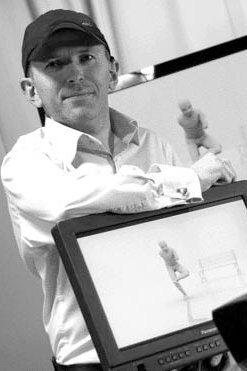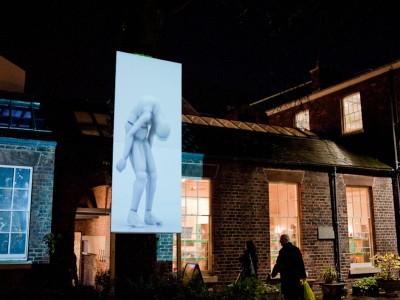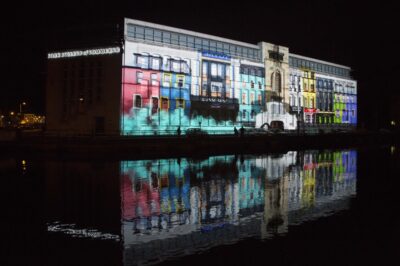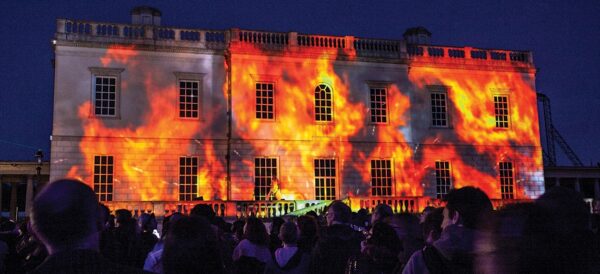Simon Mckeown, Digital Artist

Simon talks about his journey into Outdoor Arts and the influences, inspirations and experiences which led up to his spectacular work on Cork Ignite. Simon is an award-winning, internationally exhibiting artist, renowned for his work which touches on and considers disability, as well as our digital futures. (First published: Feb 2016).
How did you first get involved in Outdoor Arts?
My involvement came about as a development of my visual arts work. I had completed a very successful art project in 2009 called Motion Disabled and was asked to do a presentation at the Yorkshire Sculpture Park on this work. A question was put to me about what I would like to do next – I replied that I wanted to take the work outdoors in a large way. This then led to a huge outdoor projection organised by the arts producer Jo Verrent as part of Light Night Leeds in October 2009.
What is one of your earliest memories of Outdoor Arts?
This has to be the very lovely and brilliant Stockton International Riverside Festival. I live in North Yorkshire and have been across to see it many times!
What performance or Outdoor Arts experience made a big impression on you?
Some of the events at Stockton have been amazing. I remember two cardboard boxes falling in love in particular! How simple yet amazingly emotional. Another performance involved someone sitting in a chair leaking water everywhere, showcasing great clown and slapstick work. It was amazing to see the children’s reactions. As the World Tipped was a really impressive project with stunning aerial and video work. That said, I really enjoyed Prometheus Awakes, not least because I was the visual artist behind the projection work. I enjoyed working with Graeae Theatre, GDIF and La Fura dels Baus.
 What’s the best artistic advice you’ve been given?
What’s the best artistic advice you’ve been given?
I think this came early on in my life. My father simply said, make sure you do something in life you enjoy. I’ve always tried to follow that. Following that various art teachers really impressed me and motivated me to try and make it. Dr Paul Darke very early on in my artistic career back on 2002 I think, told me to be brave… go for it!
Where do your ideas come from?
My ideas often mix art, animation, technology, scale and disability. I really enjoy the collisions that come from this and I am always motivated to do more and take larger steps. I have a really mixed background in Fine Art, complex technology from post-production and computer games, where I worked in both areas for a long time. I have multiple disabilities including brittle bones and that experience also filters into my work.
What’s your top tip to someone wanting to work outdoors for the first time?
Explore and start small and low cost, this allows for a lot of creative freedom. Being persistent is really important and make sure you develop excellent partnerships. My recent Cork Ignite project took two years to develop and produce which is a long time. I couldn’t have done it without our overall combined persistence as a fantastic team backed up amazing partners.
What’s your funniest or most bizarre Outdoor Arts experience?
I think this has to be stumbling across a huge crane based work on Annecy in French Alps one year by accident. I was on a cycling tour and passed through the city by chance. I waited and waited and it wasn’t clear what was happening, but whenever a large crowd gathers – and you don’t know why – it sometimes it’s worth waiting. In this case, it certainly was as I witnessed a fantastic show, with drummers, cranes and aerial work all in the flavour of the French Revolution.

Describe a project or future piece of work that you’re really excited about.
Cork Ignite is the largest and most significant project I have been involved in, to date. It played out live on Culture Night in Ireland to an audience of around 7000 or more! I was invited to Cork by the National Sculpture Factory (Cork, Ireland) and Create (Dublin, Ireland) to come up with an idea for a work, which we would apply to the Irish Ignite programme for support. Building on my earlier works I suggested an outdoor spectacle and was thrilled when it was accepted. I went onto deliver with a host of partners including XL Video and Teesside University a 30-minute projection-mapped show. I had suggested as part of the process that I would work with disabled groups to create reference material and audio for the event and this collaborative element was really enjoyable and successful. Not only did the event have great disabled access it also had many disability connections throughout the work, along with elements from Cork’s history and also architectural manipulation of the building. It was also fantastic to be using six of the largest projectors in Europe.
What are your impressions on the current health of the Outdoor Arts sector?
I think the arts sector as a whole is under significant pressure in the UK, which is a great shame. There is a lot of direct evidence about the benefits of the cultural capital we deliver as a sector, which is derived from the work we do. We have a significant impact on people’s lives and yet we do not have significant resources. It is often our determination as ambitious professional creative people that results in projects being delivered, when in fact the project itself is effectively under-resourced and the artists and directors are essentially poorly paid. Whilst the creative sector offers a huge resource to the UK and creates a huge income it has always seemed a real shame that the decision-makers, don’t really take it seriously enough.
Where do you think the sector will be in 4 or 5 years?
I think we will see greater collaboration across organisations and events and we may see less ‘big’ work being conceived with more shared work delivered. Whilst on the one hand this makes great sense in a cost-saving way, it is also potentially a risk-averse strategy, and so we may see less work made overall and perhaps work that is less challenging, less diverse because it is being paid for by multiple partners for multiple uses. I would hope that challenging works, which have disability intertwined throughout, are still possible as well as fantastic events. As a nation we love outdoor work, we are a visually creative nation, In truth I would like to see all the arts budgets quadrupled at the very least and significant support and training mechanisms put in place along with a great link up with university art departments and education, all supported by a plan to make our work the most cutting edge in Europe. We are one of the world’s best in computer games, special effects and film for instance. We need similar support and the creative sector overall needs a great deal more support. The French idea of a culture tax on smartphones was very interesting.
What do you see as the biggest challenges and how do you plan to meet them?
On a personal level, it is about getting projects concluded. It took three years or more before Prometheus Awakes came to fruition and that’s a long time and is a tribute to everyone behind the scenes who persistently plugged away at making it happen. I am now trying to build on the success of Cork Ignite. If anyone would like to know more please just ask!
Who inspires you in your work?
I think companies that challenge the status quo, one that supports risky projects and artistic risk-takers. Not everything should be definite, cut and dry and we must be allowed the space to practice and make mistakes. Mary McCarthy, Director of NSF, supported by her wonderful colleagues including Kath Gorman, is such a calm collected person, operating at a high level, yet able to still see the bigger picture, and to commission and take risks. Working on such a big project over two years with Mary was a wonderful experience.
 How do you follow what’s happening in Outdoor Arts and cultural sector – what blogs, websites, publications do you recommend?
How do you follow what’s happening in Outdoor Arts and cultural sector – what blogs, websites, publications do you recommend?
I read a lot of material when I can, a lot of which is disability and art-related. I also look at a lot of festival programmes such as the Out There Festival by Seachange Arts and SIRF, of course, as well as Lumiere London and FiraTàrrega in Spain. In-Situ is really interesting as a European platform for artistic creations in public spaces.
What non-Outdoor Arts cultural experience has made a great impression on you?
I was involved in the London 2012 Festival and some of the work I completed that year culminated in an exhibition at the South Bank, London entitled Unlimited, which was lovely. I really enjoyed the exhibition that DOX Centre for Contemporary Art in Prague put together called Disabled by Normality. That left a big impression on me as it had really interesting European and historical angles.
What’s the best book/film/concert that you’ve encountered in the past 2 years?
The best book is difficult as I am just finishing writing this year for a PHD so a lot of my ready has been off the radar as a result! I really enjoyed one called A Foul and Pestilent Congregation, however which is all about Baroque Art and the history of the images of ‘freaks’ from this period. The best film would have to be Paddington, and I know that’s a kids choice, but it was just creatively and technically so well done. I recently got round to watching Sin City. I really like films influenced by dark cartoons I think because they are really interesting visually. The best concert would Pete Williams (bassist in Dexy’s Midnight Runners) playing in Sheffield in a tiny pub with band members from Richard Hawley and Imelda May. I’m not over keen on Dexy’s, but this was completely different and one of the best small gigs I’ve been to.
Who would you have at your dream fantasy picnic?
I’d like to chat with my grandad, who died when I was five. He has inadvertently influenced me a lot and it would be great to catch up. Likewise, it would be lovely to chat with my old art teachers; they were very important to me when I was young, injured a lot and struggling. Art-wise, a drink with Francis Bacon would be great. I can think of so many people alive and dead from the art world, history, politics and so on! I wish we could do this. Whoever, it would be lovely to have my family there too!
Any top tips for Outdoor Arts practitioners?
From the onset, start to do your own work; be innovative and small and document it very well. Follow your intuition and what you care about and promote your work as well as you can! Attend the conferences and events, learn and talk.

